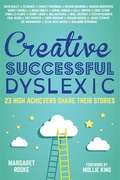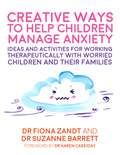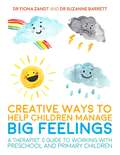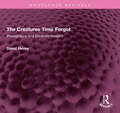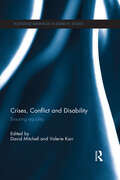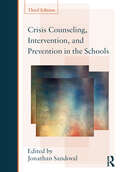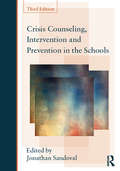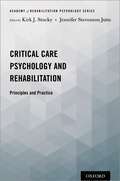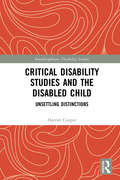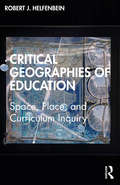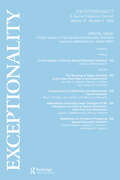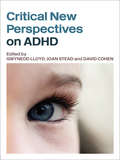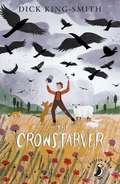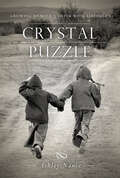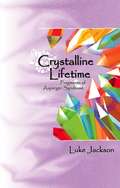- Table View
- List View
Creative, Successful, Dyslexic: 23 High Achievers Share Their Stories (PDF)
by Benjamin Zephaniah Brian Conley Charley Boorman Chris Robshaw Darcey Bussell Cbe David Bailey Cbe Ed Baines Eddie Izzard Kelly Hoppen Mbe Kenny Logan Lynda La Cbe Marcus Brigstocke Margaret Rooke Meg Mathews Mollie King Nigel Mccrery Paul Nixon Richard Rogers Sir Jackie Obe Sir Richard Branson Sophie Conran Steven Naismith Theo Paphitis Zelda West-Meads Zoe Wanamaker Cbe23 very well-known people from the arts, sport, and business worlds talk about how dyslexia affected their childhood, how they were able to overcome the challenges and use the special strengths of dyslexia to achieve great success in adulthood. Darcey Bussell CBE, Eddie Izzard, Sir Richard Branson, Meg Mathews, Zoe Wanamaker CBE, Richard Rogers, Benjamin Zephaniah, Steven Naismith, Lynda La Plante CBE, Sir Jackie Stewart OBE, Sophie Conran and others share their stories, and their advice. All reveal the enormous difficulties they faced, the strength required to overcome them, the crucial importance of adult support, and how `the different way the brain is wired' in dyslexia has enabled them to see something different in the world and to use their creativity in an exceptional way. They talk about `thinking sideways', and the ability to look at a bigger picture, the often strong visual strength, and the ability to listen, and to grasp simplicity where other people see only complexity. They also talk about how dyslexia continues to challenge them, and the ways they have found to work around this. An introduction, and final section that includes practical information about dyslexia, are written with the support of Dyslexia Action, and a percentage of profit from the book is donated to Dyslexia Action. The book will be essential reading for teachers and other professionals, and for families affected by dyslexia, and inspirational for people with dyslexia.
Creative Ways to Help Children Manage Anxiety: Ideas and Activities for Working Therapeutically with Worried Children and Their Families
by Fiona Zandt Suzanne BarrettThis book sets out therapeutic activities to help children aged 4-12 years and their families to better understand and manage anxiety. It explains how to work with anxious children, providing a framework for assessment and therapy that draws on CBT, ACT and narrative therapy approaches. Lots of practical tips for therapists are included and important developmental considerations are discussed, including adapting therapy for children with developmental difficulties, and working with families and schools.Over 50 playful therapeutic activities are included, which have been developed through the authors' extensive work with children, giving children an arsenal of coping strategies. They focus on key areas such as understanding anxiety, managing anxious thoughts, and building resilience and use readily available, inexpensive materials and downloadable templates which are provided in the book. This is the perfect tool for therapists looking for playful and purposeful ways to work with children with anxiety.
Creative Ways to Help Children Manage Anxiety: Ideas and Activities for Working Therapeutically with Worried Children and Their Families
by Fiona Zandt Suzanne BarrettThis book sets out therapeutic activities to help children aged 4-12 years and their families to better understand and manage anxiety. It explains how to work with anxious children, providing a framework for assessment and therapy that draws on CBT, ACT and narrative therapy approaches. Lots of practical tips for therapists are included and important developmental considerations are discussed, including adapting therapy for children with developmental difficulties, and working with families and schools.Over 50 playful therapeutic activities are included, which have been developed through the authors' extensive work with children, giving children an arsenal of coping strategies. They focus on key areas such as understanding anxiety, managing anxious thoughts, and building resilience and use readily available, inexpensive materials and downloadable templates which are provided in the book. This is the perfect tool for therapists looking for playful and purposeful ways to work with children with anxiety.
Creative Ways to Help Children Manage BIG Feelings: A Therapist's Guide to Working with Preschool and Primary Children (PDF)
by Dr Fiona Zandt Dr Lesley Bretherton Dr Suzanne BarrettTo be able to effectively offer therapy to children, complex therapeutic concepts need to be presented in an appropriate and engaging manner. This practical guide provides clinicians with a way in which to do so, with numerous games and imaginative activities to help children aged 4-12 to express and understand their feelings. Part I provides a comprehensive guide to working therapeutically with children and families, while Part II outlines 47 creative therapeutic activities. Each activity is presented with clear instructions using inexpensive and readily available resources and the objective and rationale of each activity is given, making it easily applicable. Activities range from using an easy to make volcano to help children better understand anger, to using a ball of string to illustrate how one person's feelings affect the whole family. This book is an invaluable resource for newly qualified clinicians, and also a treasure trove of creative ideas for experienced therapists.
The Creatures Time Forgot: Photography and Disability Imagery (Routledge Revivals)
by David HeveyFirst published in 1992, The Creatures Time Forgot examines the representation of disabled people – in advertising, particularly that produced by disability charities, and in the work of photographers such as Diane Arbus and Gary Winogrand. He shows how such images construct disabled people as ‘creatures,’ the tragic-but-brave objects of photographic gaze, or as the ‘’appy ‘andicapped’ of ‘positive imagery’ advertising. As a disabled photographer and writer, David Hevey has been a pioneer in challenging such visual representations of disabled people. His work advocates a move away from medical, charity or impairment-fixated imagery towards a visual equivalent of ‘Rights not Charity’. The book outlines David Hevey’s own photographic practice and includes wide-ranging selections from his work to create a visual form which reflects the new social presence of disabled people. This book will be of interest to students of media studies, cultural studies, and disability studies.
The Creatures Time Forgot: Photography and Disability Imagery (Routledge Revivals)
by David HeveyFirst published in 1992, The Creatures Time Forgot examines the representation of disabled people – in advertising, particularly that produced by disability charities, and in the work of photographers such as Diane Arbus and Gary Winogrand. He shows how such images construct disabled people as ‘creatures,’ the tragic-but-brave objects of photographic gaze, or as the ‘’appy ‘andicapped’ of ‘positive imagery’ advertising. As a disabled photographer and writer, David Hevey has been a pioneer in challenging such visual representations of disabled people. His work advocates a move away from medical, charity or impairment-fixated imagery towards a visual equivalent of ‘Rights not Charity’. The book outlines David Hevey’s own photographic practice and includes wide-ranging selections from his work to create a visual form which reflects the new social presence of disabled people. This book will be of interest to students of media studies, cultural studies, and disability studies.
Crises, Conflict and Disability: Ensuring Equality (Routledge Advances in Disability Studies)
by Valerie Karr David MitchellPeople with disabilities are among the most adversely affected during conflict situations or when natural disasters strike. They experience higher mortality rates, have fewer available resources and less access to help, especially in refugee camps, as well as in post-disaster environments. Already subject to severe discrimination in many societies, people with disabilities are often overlooked during emergency evacuation, relief, recovery and rebuilding efforts. Countries party to the UN Convention on the Rights of Persons with Disabilities must take all necessary measures to ensure the protection and safety of people with disabilities during situations of armed conflict, humanitarian emergencies, and natural disasters. Such aid should be designed to support preparedness, response, recovery and rebuilding. This book includes perspectives from around the globe and explores the implications at the policy, programme, and personal level, discussing issues such as: How can national laws, policies, and regulations provide guidance, methods and strategies to integrate and coordinate inclusive emergency management? What should people with disabilities know in order to be prepared for emergency situations? What lessons have we learned from past experiences? What are the current shortfalls (physical and cultural) that put people with disabilities at risk during emergencies and what can be done to improve these situations (e.g. through new technologies and disaster planning)? How does disability affect people’s experiences as refugees and other displaced situations; what programmes and best practices are in place to protect and promote their rights during their period of displacement? How must disabled people with disabilities be factored in to the resettlement and rebuilding process; does an opportunity for ensuring universal access exist in the rebuilding process? What is the impact of disasters and conflicts on such special populations as disabled women, disabled children, and those with intellectual disabilities? Spotlighting a pressing issue that has long been neglected in emergency planning fields, this innovative book discusses how to meet the needs of people with disabilities in crises and conflict situations. It is an important reference for all those working in or researching disability and inclusion, and emergency and disaster management, both in developed and developing countries.
Crises, Conflict and Disability: Ensuring Equality (Routledge Advances in Disability Studies)
by David Mitchell Valerie KarrPeople with disabilities are among the most adversely affected during conflict situations or when natural disasters strike. They experience higher mortality rates, have fewer available resources and less access to help, especially in refugee camps, as well as in post-disaster environments. Already subject to severe discrimination in many societies, people with disabilities are often overlooked during emergency evacuation, relief, recovery and rebuilding efforts. Countries party to the UN Convention on the Rights of Persons with Disabilities must take all necessary measures to ensure the protection and safety of people with disabilities during situations of armed conflict, humanitarian emergencies, and natural disasters. Such aid should be designed to support preparedness, response, recovery and rebuilding. This book includes perspectives from around the globe and explores the implications at the policy, programme, and personal level, discussing issues such as: How can national laws, policies, and regulations provide guidance, methods and strategies to integrate and coordinate inclusive emergency management? What should people with disabilities know in order to be prepared for emergency situations? What lessons have we learned from past experiences? What are the current shortfalls (physical and cultural) that put people with disabilities at risk during emergencies and what can be done to improve these situations (e.g. through new technologies and disaster planning)? How does disability affect people’s experiences as refugees and other displaced situations; what programmes and best practices are in place to protect and promote their rights during their period of displacement? How must disabled people with disabilities be factored in to the resettlement and rebuilding process; does an opportunity for ensuring universal access exist in the rebuilding process? What is the impact of disasters and conflicts on such special populations as disabled women, disabled children, and those with intellectual disabilities? Spotlighting a pressing issue that has long been neglected in emergency planning fields, this innovative book discusses how to meet the needs of people with disabilities in crises and conflict situations. It is an important reference for all those working in or researching disability and inclusion, and emergency and disaster management, both in developed and developing countries.
Crisis Counseling, Intervention and Prevention in the Schools (Consultation, Supervision, and Professional Learning in School Psychology Series)
by Jonathan SandovalSince the first edition was published in 1988, the role of crisis intervention and prevention has become central to mental health professionals working in the schools. Disasters such as hurricane Katrina, terrorist attacks both in this country and around the world, and various school shootings have greatly increased school crisis research and policy development. This book is designed for an introductory graduate course taken by students in school psychology, school counseling, and school social work. Section I provides a crisis response overview, section II deals with crises for children and adolescents and section III covers crises that manifest in adolescence. Discussions of the 16 most prevalent types of crises are covered in sections II and III and include their characteristics, causes, interventions, and preventive programs. All chapters will be updated, six heavily revised or totally rewritten by new authors, and two new chapters (chapters 8 & 19) have been added.
Crisis Counseling, Intervention and Prevention in the Schools (Consultation, Supervision, and Professional Learning in School Psychology Series)
by Jonathan SandovalSince the first edition was published in 1988, the role of crisis intervention and prevention has become central to mental health professionals working in the schools. Disasters such as hurricane Katrina, terrorist attacks both in this country and around the world, and various school shootings have greatly increased school crisis research and policy development. This book is designed for an introductory graduate course taken by students in school psychology, school counseling, and school social work. Section I provides a crisis response overview, section II deals with crises for children and adolescents and section III covers crises that manifest in adolescence. Discussions of the 16 most prevalent types of crises are covered in sections II and III and include their characteristics, causes, interventions, and preventive programs. All chapters will be updated, six heavily revised or totally rewritten by new authors, and two new chapters (chapters 8 & 19) have been added.
Critical Care Psychology and Rehabilitation: Principles and Practice (Academy of Rehabilitation Psychology Series)
by Kirk J. Stucky Jennifer Stevenson JutteThe primary focus of critical care is doing everything necessary to save lives. With so many things to manage, it comes as no surprise that the complex, multi-layered issues faced by critical illness survivors cannot be managed by intensive care specialists alone. Critical Care Psychology and Rehabilitation provides insight into holistic care of survivors. Written by leading experts, the book builds upon current literature and illustrates the benefits of integrating psychological and rehabilitation techniques throughout the care continuum. Chapters include summaries of treatment techniques, developments in intensive care settings, support and training for staff, and opportunities for further research. Although all chapters are relevant to contemporary psychology practice, the book is written in a style that is accessible to a wide audience of physicians, nurses, and other health professionals. Critical Care Psychology and Rehabilitation offers tools to improve the quality of intensive and post intensive care, with positive outcomes for patients, families, and caregivers.
Critical Care Psychology and Rehabilitation: Principles and Practice (Academy of Rehabilitation Psychology Series)
by Kirk J. Stucky Jennifer Stevenson JutteThe primary focus of critical care is doing everything necessary to save lives. With so many things to manage, it comes as no surprise that the complex, multi-layered issues faced by critical illness survivors cannot be managed by intensive care specialists alone. Critical Care Psychology and Rehabilitation provides insight into holistic care of survivors. Written by leading experts, the book builds upon current literature and illustrates the benefits of integrating psychological and rehabilitation techniques throughout the care continuum. Chapters include summaries of treatment techniques, developments in intensive care settings, support and training for staff, and opportunities for further research. Although all chapters are relevant to contemporary psychology practice, the book is written in a style that is accessible to a wide audience of physicians, nurses, and other health professionals. Critical Care Psychology and Rehabilitation offers tools to improve the quality of intensive and post intensive care, with positive outcomes for patients, families, and caregivers.
Critical Disability Studies and the Disabled Child: Unsettling Distinctions (Interdisciplinary Disability Studies)
by Harriet CooperThis book examines the relationship between contemporary cultural representations of disabled children on the one hand, and disability as a personal experience of internalised oppression on the other. In focalising this debate through an exploration of the politically and emotionally charged figure of the disabled child, Harriet Cooper raises questions both about what it means to ‘speak for’ the other and about what resistance means when one is unknowingly invested in one’s own abjection. Drawing on both the author’s personal experience of growing up with a physical impairment and on a range of critical theories and cultural objects – from Frances Hodgson Burnett’s novel The Secret Garden to Judith Butler’s work on injurious speech – the book theorises the making of disabled and ‘rehabilitated’ subjectivities. With a conceptual framework informed by both psychoanalysis and critical disability studies, it investigates the ways in which cultural anxieties about disability come to be embodied and lived by the disabled child. Posing new questions for disability studies and for identity politics about the relationships between lived experiences, cultural representations and dominant discourses – and demonstrating a new approach to the concept of ‘internalised oppression’ – this book will be of interest to scholars and students of disability studies, medical humanities, sociology and psychosocial studies, as well as to those with an interest in identity politics more generally.
Critical Disability Studies and the Disabled Child: Unsettling Distinctions (Interdisciplinary Disability Studies)
by Harriet CooperThis book examines the relationship between contemporary cultural representations of disabled children on the one hand, and disability as a personal experience of internalised oppression on the other. In focalising this debate through an exploration of the politically and emotionally charged figure of the disabled child, Harriet Cooper raises questions both about what it means to ‘speak for’ the other and about what resistance means when one is unknowingly invested in one’s own abjection. Drawing on both the author’s personal experience of growing up with a physical impairment and on a range of critical theories and cultural objects – from Frances Hodgson Burnett’s novel The Secret Garden to Judith Butler’s work on injurious speech – the book theorises the making of disabled and ‘rehabilitated’ subjectivities. With a conceptual framework informed by both psychoanalysis and critical disability studies, it investigates the ways in which cultural anxieties about disability come to be embodied and lived by the disabled child. Posing new questions for disability studies and for identity politics about the relationships between lived experiences, cultural representations and dominant discourses – and demonstrating a new approach to the concept of ‘internalised oppression’ – this book will be of interest to scholars and students of disability studies, medical humanities, sociology and psychosocial studies, as well as to those with an interest in identity politics more generally.
Critical Geographies of Education: Space, Place, and Curriculum Inquiry
by Robert J. HelfenbeinWINNER 2023 Society of Professors of Education Outstanding Book AwardCritical Geographies of Education: Space, Place, and Curriculum Inquiry is an attempt to take space seriously in thinking about school, schooling, and the place of education in larger society. In recent years spatial terms have emerged and proliferated in academic circles, finding application in several disciplines extending beyond formal geography. Critical Geography, a reconceptualization of the field of geography rather than a new discipline itself, has been theoretically considered and practically applied in many other disciplines, mostly represented by what is collectively called social theory (i.e., anthropology, sociology, cultural studies, political science, and literature). The goal of this volume is to explore how the application of the ideas and practices of Critical Geography to educational theory in general and curriculum theorizing in specific might point to new trajectories for analysis and inquiry. This volume provides a grounding introduction to the field of Critical Geography, making connections to the significant implications it has for education, and by providing illustrations of its application to specific educational situations (i.e., schools, classrooms, and communities). Presented as an intellectual geography that traces how spatial analysis can be useful in curriculum theorizing, social foundations of education, and educational research, the book surveys a range of issues including social justice and racial equity in schools, educational reform, internationalization of the curriculum, and how schools are placed within the larger social fabric.
Critical Geographies of Education: Space, Place, and Curriculum Inquiry
by Robert J. HelfenbeinWINNER 2023 Society of Professors of Education Outstanding Book AwardCritical Geographies of Education: Space, Place, and Curriculum Inquiry is an attempt to take space seriously in thinking about school, schooling, and the place of education in larger society. In recent years spatial terms have emerged and proliferated in academic circles, finding application in several disciplines extending beyond formal geography. Critical Geography, a reconceptualization of the field of geography rather than a new discipline itself, has been theoretically considered and practically applied in many other disciplines, mostly represented by what is collectively called social theory (i.e., anthropology, sociology, cultural studies, political science, and literature). The goal of this volume is to explore how the application of the ideas and practices of Critical Geography to educational theory in general and curriculum theorizing in specific might point to new trajectories for analysis and inquiry. This volume provides a grounding introduction to the field of Critical Geography, making connections to the significant implications it has for education, and by providing illustrations of its application to specific educational situations (i.e., schools, classrooms, and communities). Presented as an intellectual geography that traces how spatial analysis can be useful in curriculum theorizing, social foundations of education, and educational research, the book surveys a range of issues including social justice and racial equity in schools, educational reform, internationalization of the curriculum, and how schools are placed within the larger social fabric.
Critical Issues in Training Special Education Teachers: A Special Issue of exceptionality
by Laurie U. DeBettencourtFirst Published in 2005. Routledge is an imprint of Taylor & Francis, an informa company.
Critical Issues in Training Special Education Teachers: A Special Issue of exceptionality
by Laurie U. DeBettencourtFirst Published in 2005. Routledge is an imprint of Taylor & Francis, an informa company.
Critical New Perspectives on ADHD
by Gwynedd LloydExperts from all over the world take a critical, highly international and often controversial perspective on the ADHD phenomenon – a condition that has reached global proportions, significantly affecting the lives of children, parents and teachers worldwide. This book raises a number of concerns often not covered by the material currently available to parents and practitioners. Critical New Perspectives on ADHD unpicks the myths surrounding the development of this phenomenon and leaves no stone unturned in its search for answers. An in-depth exploration into the reasons for the emergence and maintenance of ADHD lead to suggested explanations of the dominance of US psychiatric models and the need for new markets for major pharmaceutical companies, as well as the functions that ADHD diagnoses fulfil in families, classrooms and communities. In a world where moves to educational inclusion are paradoxically paralleled by the ever-increasing use of medication to control children’s behaviour, this book scrutinises current accepted practice and offers alternative perspectives and strategies for teachers and other education professionals. This in an invaluable resource for anyone with a serious interest in ADHD and other behavioural difficulties.
Critical New Perspectives on ADHD
by Gwynedd Lloyd Joan Stead David CohenExperts from all over the world take a critical, highly international and often controversial perspective on the ADHD phenomenon – a condition that has reached global proportions, significantly affecting the lives of children, parents and teachers worldwide. This book raises a number of concerns often not covered by the material currently available to parents and practitioners. Critical New Perspectives on ADHD unpicks the myths surrounding the development of this phenomenon and leaves no stone unturned in its search for answers. An in-depth exploration into the reasons for the emergence and maintenance of ADHD lead to suggested explanations of the dominance of US psychiatric models and the need for new markets for major pharmaceutical companies, as well as the functions that ADHD diagnoses fulfil in families, classrooms and communities. In a world where moves to educational inclusion are paradoxically paralleled by the ever-increasing use of medication to control children’s behaviour, this book scrutinises current accepted practice and offers alternative perspectives and strategies for teachers and other education professionals. This in an invaluable resource for anyone with a serious interest in ADHD and other behavioural difficulties.
Crocodiles Can't Climb Trees: Targeting the k Sound (Speech Bubbles 1)
by Melissa PalmerLucas the Monkey loves to play soccer by the river, but he has a problem – Mr. Crocodile, who would love to make Lucas his dinner. This picture book targets the /k/ sound, and is part of Speech Bubbles 1, a series of picture books that target specific speech sounds within the story. The series can be used for children receiving speech therapy, for children who have a speech sound delay/disorder, or simply as an activity for children’s speech sound development and/or phonological awareness. They are ideal for use by parents, teachers or caregivers. Bright pictures and a fun story create an engaging activity perfect for sound awareness. Please see other titles in the series for stories targeting other speech sounds.
Crocodiles Can't Climb Trees: Targeting the k Sound (Speech Bubbles 1)
by Melissa PalmerLucas the Monkey loves to play soccer by the river, but he has a problem – Mr. Crocodile, who would love to make Lucas his dinner. This picture book targets the /k/ sound, and is part of Speech Bubbles 1, a series of picture books that target specific speech sounds within the story. The series can be used for children receiving speech therapy, for children who have a speech sound delay/disorder, or simply as an activity for children’s speech sound development and/or phonological awareness. They are ideal for use by parents, teachers or caregivers. Bright pictures and a fun story create an engaging activity perfect for sound awareness. Please see other titles in the series for stories targeting other speech sounds.
The Crowstarver (A\puffin Book Ser.)
by Dick King-SmithA beautiful story for older readers written almost twenty years ago in which bestselling author Dick King-Smith creates a fascinating picture of rural life at the time of the Second World War. Discovered as a foundling in a lambing pen, Spider Sparrow grows up surrounded by animals. From sheep and horses to wild otters and foxes, Spider loves them all, even the crows he must scare away from the newly sown wheat. Crowstarving was the idea job for Spider - he was on his own, yet never alone for all around him were animals of one sort or another. Amazingly, every animal who meets Spider implicitly trusts the young boy. This magical rapport is Spider's unique gift, but nothing else in his tough life is so easy.
Crystal Puzzle: Growing Up with a Sister with Asperger's
by Ashley NanceA delightful, true story of growing up with a sister with Asperger's syndrome.
Crystalline Lifetime: Fragments of Asperger Syndrome (PDF)
by Luke Jackson'This beautiful book is written by an astute 17 year-old with Aspergers Syndrome. It tells some of his life story in his own poetic words; I am sure many of you, with or without Aspergers, will relate to his poetry, photography and illustrations. This book lets us gently into his world and shares with us some of the challenges he faced as an adolescent on the autistic spectrum.' - NAGC Magazine 'A remarkable achievement for a teenager seeking to find his way through the confusion and frustration of living with Asperger syndrome.' - Current Awareness Service This illustrated collection of Luke Jackson's insightful and often poignant poems offers a glimpse of the emotional and visual sensibilities of people on the autism spectrum in their adolescent years - perhaps the most challenging time for anyone with Asperger Syndrome (AS). Luke writes perceptively about identity, struggle, loneliness, love and the pursuit of happiness, and about finding calm amid the often overwhelming confusion and frustration that accompanies AS.
